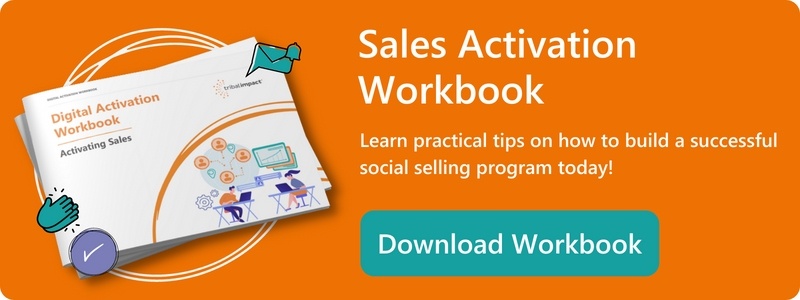A few years ago, social selling was new and exciting. Now, it’s taken as a given go-to strategy for many enterprises.
HootSuite’s recent Social Transformation Report shows that 46% of “socially mature” organisations have now extended social media usage activities into their sales.
And with LinkedIn’s State of Sales Report 2020 showing that 45% of professionals have indicated that they expect a permanent shift in how they work as a result of COVID-19, it’s likely we’ll see social selling strategies continue to become more widely adopted.
We’re seeing this reflected in the questions we now receive from enterprises. They’re now less focused on the why and instead they want to know how best to scale their efforts into a global social selling programme. Or a global Centre of Excellence.
Scaling your social selling success throughout the entire enterprise is no mean feat but if you’re reading this, you’ve likely already experienced the late and sleepless nights, the push-backs and fine tuning needed to make your program a success.
Here’s how to capitalise on your initial success and overcome the unique challenges of going global with social selling.
1. The Importance Of Globalised, Yet Localised Expertise
"And really, The Golden Rule is you've got to be embedded in that culture and really understand it and become a user before you can begin to sort of preach as to what people there should be doing. That's always been sort of my doctrine, my mantra."
Neil Schaffer, Fractional CMO and author of the Age of Influence
Source: Tribal Impact’s Campfire Chat, The Age of Influence & Social Business
While a global framework and approach to social selling is critical in enterprise companies, local knowledge, enablement and expertise is still crucial for these reasons:
- Social media habits - and even which platforms to use - vary in different continents (and even countries).
- Which social selling tactics work best will vary wildly. (An InMail template that receives a high response rate in the US may fail to engage prospects and buyers in South Africa.)
- Peers will always be your best source of buy-in for social selling programmes
- You need a constant feedback loop, with ears to the ground
- The socio-political climate of each country can result in a wildly different approach
2. Leaders Offer ‘Learning As A Service’
“If you don’t offer performance support in the moment of need, if you’re not able to do that as a company, then it will be really difficult for the learning function to stay relevant...It's not software as a service but learning as a service."
Francisco “Paco” Pelzing is Head of International Sales at Hemsley Fraser
Source: Francisco Pelzing, Tribal Campfire Chat
If you’re going to create a global Centre of Excellence, then your L&D needs to be a leader. According to McKInsey, blended learning should lie at the heart of the revolutionary change needed in corporate learning.
So how do you do that?
Francisco “Paco” Pelzing is Head of International Sales at Hemsley Fraser - a worldwide training provider with state-of-the-art training facilities. As he told Sarah here, we need to support employees with the relevant learning methodologies.
And for him, that lies in a 70/20/10 approach:
- 10% is classroom training
- 20% is social learning (i.e. peer learning and coaching)
- 70% is when you apply what you learn
As he told us: if you don’t support the initial classroom training with social learning, then 87% will otherwise be lost after 30 days. And when you apply what you learn, it reinforces it - by training it out, failing and trying again.
3. Steal Silicon Valley’s “Design Thinking” Approach
You may wonder how design thinking - an approach to problem solving used in the depths of Silicon Valley that encourages creativity and a “fail fast, fail small” approach - can help with social selling in a corporate world.
The truth is: quite a lot. They always say that the most innovative businesses take their best ideas from other industries. And Learning & Development professionals in the social selling space are beginning to realise the importance of design thinking. In fact, LinkedIn Live invited our in-house L&D expert Justyna Brownridge and others to discuss this recently.
You can read more about why and how to apply design thinking to social selling here. In short, it involves empathising with your users’ needs and challenges first and then testing and optimising a working prototype (or a pilot) before delivering it at scale.
So as you scale globally, remember to keep testing with pilots in each new region and improving via continual feedback. That way you can control your investment and keep your new region’s social selling budget for once you’ve tweaked and optimised your strategy.

4. Relying On Contractors For Upskilling Isn’t Sustainable
On LinkedIn, there was a 63% increase in marketing jobs in the first half of 2021. 50% of the top jobs are in the Digital or Media space.
Source: LinkedIn: 2021 Marketing Jobs Outlook
One of the biggest complaints we hear from those in charge of social selling programmes is that they don’t have enough headcount to deal with all the varying skill sets required.
They’re often juggling many hats and social programmes. Then, as we’ve touched on, there are the skill sets required - training, 121 coaching, local knowledge and niche industry and departmental expertise. Not to mention, ensuring that they don’t get left behind!
Outsourcing training and enablement is therefore often the go-to solution but, with social media and the required skillsets constantly changing, outsourcing can quickly become an expensive and unsustainable solution.
That’s why socially savvy global players are beginning to expect more from their social selling training and coaching partners. They want a short-term ramp-up of support along with help creating an L&D training model for social selling that’s self-reliant.
A social selling partner should be able to provide a lifeline with services like done-for-you “kickstarts” for busy executives when you need results and buy-in fast.
But just like with any investment, you should always have your “exit point” in mind and your partner should help you achieve this by enabling your existing internal experts and enthusiasts e.g. through Train the Trainer, Coach the Coach and training that enables your Social Champions to offer peer-to-peer support.
As Ericsson’s Global Head of Social Engagement & Advocacy, Anita Veszeli, says in her LinkedIn article, “How do you piece together a social-first business?”:
“Creating a social-first business - with social media built into your company’s DNA – is like piecing together a really tricky jigsaw.”
Discover how Anita scaled social selling across Ericsson and achieved Leader Status in Hootsuite’s Social Media Maturity Benchmark but it’s not been easy.

